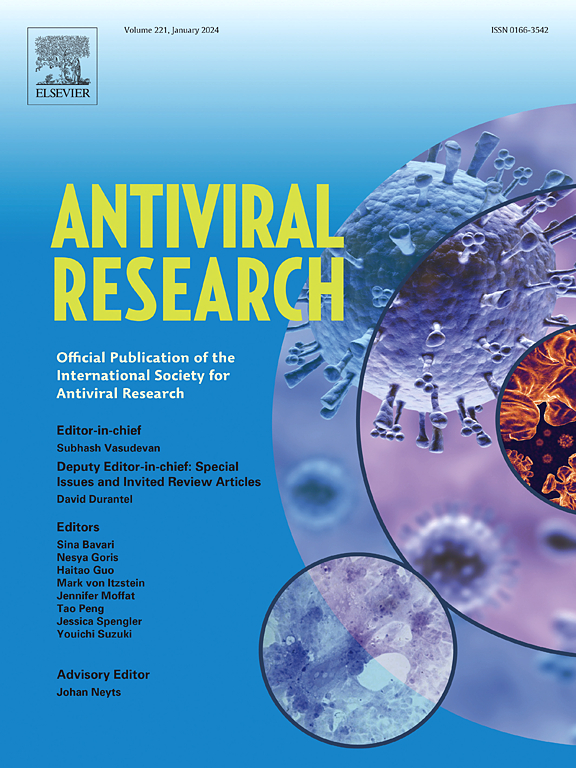Targeting the host transcription factor HSF1 prevents human cytomegalovirus replication in vitro and in vivo
IF 4.5
2区 医学
Q1 PHARMACOLOGY & PHARMACY
引用次数: 0
Abstract
FDA-approved antivirals against HCMV have several limitations, including only targeting the later stages of the viral replication cycle, adverse side effects, and the emergence of drug-resistant strains. Antivirals targeting host factors specifically activated within infected cells and necessary for viral replication could address the current drawbacks of anti-HCMV standard-of-care drugs. In this study, we found HCMV infection stimulated the activation of the stress response transcription factor heat shock transcription factor 1 (HSF1). HCMV entry into fibroblasts rapidly increased HSF1 activity and subsequent relocalization from the cytoplasm to the nucleus, which was maintained throughout viral replication and in contrast to the transient burst of activity induced by canonical heat shock. Prophylactic pharmacological inhibition or genetic depletion of HSF1 prior to HCMV infection attenuated the expression of all classes of viral genes, including immediate early (IE) genes, and virus production, suggesting HSF1 promotes the earliest stages of the viral replication cycle. Therapeutic treatment with SISU-102, an HSF1 inhibitor tool compound, after IE expression also reduced the levels of L proteins and progeny production, suggesting HSF1 regulates multiple steps along the HCMV replication cycle. Leveraging a newly developed human skin xenograft transplant murine model, we found prophylactic treatment with SISU-102 significantly attenuated viral replication in transplanted human skin xenografts as well as viral dissemination to distal sites. These data demonstrate HCMV infection rapidly activates and relocalizes HSF1 to the nucleus to promote viral replication, which can be exploited as a host-directed antiviral strategy.
靶向宿主转录因子HSF1在体外和体内阻止人巨细胞病毒复制
fda批准的HCMV抗病毒药物有几个局限性,包括仅针对病毒复制周期的后期阶段、不良副作用和耐药菌株的出现。针对感染细胞内特异性激活的宿主因子和病毒复制所必需的抗病毒药物可以解决当前抗hcmv标准治疗药物的缺点。在本研究中,我们发现HCMV感染刺激应激反应转录因子热休克转录因子1 (HSF1)的激活。HCMV进入成纤维细胞迅速增加HSF1的活性,随后从细胞质向细胞核的重新定位,这在整个病毒复制过程中保持不变,与典型热休克诱导的短暂的活性爆发相反。在HCMV感染前预防性药物抑制或基因耗尽HSF1可降低所有类型病毒基因的表达,包括即时早期(IE)基因和病毒的产生,这表明HSF1促进了病毒复制周期的早期阶段。在IE表达后,用HSF1抑制剂工具化合物SISU-102进行治疗也降低了L蛋白水平和后代的产生,这表明HSF1调节了HCMV复制周期的多个步骤。利用新开发的人类皮肤异种移植小鼠模型,我们发现用SISU-102进行预防性治疗可显著减少移植的人类皮肤异种移植中的病毒复制以及病毒向远端部位的传播。这些数据表明HCMV感染迅速激活并将HSF1重新定位到细胞核以促进病毒复制,这可以作为一种宿主导向的抗病毒策略。
本文章由计算机程序翻译,如有差异,请以英文原文为准。
求助全文
约1分钟内获得全文
求助全文
来源期刊

Antiviral research
医学-病毒学
CiteScore
17.10
自引率
3.90%
发文量
157
审稿时长
34 days
期刊介绍:
Antiviral Research is a journal that focuses on various aspects of controlling viral infections in both humans and animals. It is a platform for publishing research reports, short communications, review articles, and commentaries. The journal covers a wide range of topics including antiviral drugs, antibodies, and host-response modifiers. These topics encompass their synthesis, in vitro and in vivo testing, as well as mechanisms of action. Additionally, the journal also publishes studies on the development of new or improved vaccines against viral infections in humans. It delves into assessing the safety of drugs and vaccines, tracking the evolution of drug or vaccine-resistant viruses, and developing effective countermeasures. Another area of interest includes the identification and validation of new drug targets. The journal further explores laboratory animal models of viral diseases, investigates the pathogenesis of viral diseases, and examines the mechanisms by which viruses avoid host immune responses.
 求助内容:
求助内容: 应助结果提醒方式:
应助结果提醒方式:


